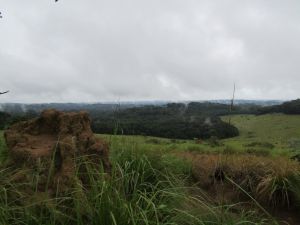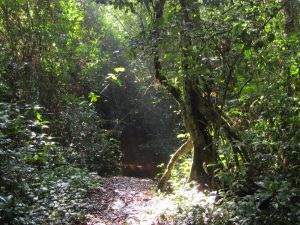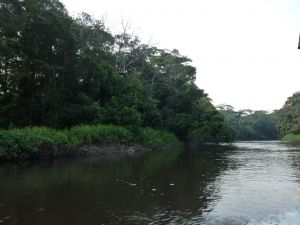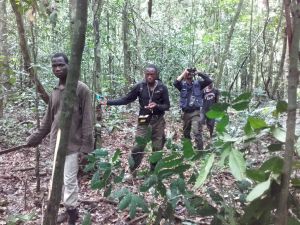Difference between revisions of "Salonga National Park (South Block)"
| (9 intermediate revisions by the same user not shown) | |||
| Line 11: | Line 11: | ||
= Summary = <!-- An overview of the site, with one sentence for each section. May include a site map --> | = Summary = <!-- An overview of the site, with one sentence for each section. May include a site map --> | ||
* Bonobos (''Pan paniscus'') are present in the south block of Salonga National Park. | * Bonobos (''Pan paniscus'') are present in the south block of Salonga National Park. | ||
| − | * It has been estimated that 9,246 (CI 3,596-20,720) individuals occur in the site. | + | * It has been estimated that 9,246 (CI: 3,596-20,720) individuals occur in the site. |
* The bonobo population trend is stable. | * The bonobo population trend is stable. | ||
* The site has a total size of 17,127 km². | * The site has a total size of 17,127 km². | ||
| Line 18: | Line 18: | ||
* Salonga is the only national park in the geographic range of bonobos. | * Salonga is the only national park in the geographic range of bonobos. | ||
<div><ul> | <div><ul> | ||
| − | <li style="display: inline-block;">[[File: Anga station.jpg | 300px | thumb| right |View of Salonga National Park, South Block, from the guard Station of Anga © Mattia Bessone]] | + | <li style="display: inline-block;">[[File: Anga station.jpg | 300px | thumb| right |View of Salonga National Park, South Block, from the guard Station of Anga © Mattia Bessone – PNS Survey]] |
| − | <li style="display: inline-block;"> [[File: Stream Anga sector.jpg | 300px | thumb| right | A small stream on the path to Iyaelima, Sector of Anga © Mattia Bessone]] | + | <li style="display: inline-block;"> [[File: Stream Anga sector.jpg | 300px | thumb| right | A small stream on the path to Iyaelima, Sector of Anga © Mattia Bessone – PNS Survey]] |
| − | <li style="display: inline-block;">[[File: Luilaka river.jpg | 300px | thumb| right | Luilaka river, Sector of Monkoto © Mattia Bessone]] | + | <li style="display: inline-block;">[[File: Luilaka river.jpg | 300px | thumb| right | Luilaka river, Sector of Monkoto © Mattia Bessone – PNS Survey]] |
</ul></div> | </ul></div> | ||
= Site characteristics = <!-- A paragraph summary of physical and geographic aspects of the site, and a table of key information --> | = Site characteristics = <!-- A paragraph summary of physical and geographic aspects of the site, and a table of key information --> | ||
Salonga National Park (SNP) is the largest protected area of pristine rainforest in the African continent (33,500 km²). Located south of the Congo river, in the Democratic Republic of the Congo, it is a [https://whc.unesco.org/en/list/280/ UNESCO World Heritage] site and a stronghold for many endangered species. SNP, is divided into two blocks, North and South, separated by a 45 km wide inhabited buffer zone. Since 2015, the park is co-managed by the Congolese Institute for Nature Conservation (ICCN) in collaboration with the World Wide Fund for Nature ([https://www.wwf-congobasin.org/where_we_work/priority_places/salonga_national_park/ WWF]). | Salonga National Park (SNP) is the largest protected area of pristine rainforest in the African continent (33,500 km²). Located south of the Congo river, in the Democratic Republic of the Congo, it is a [https://whc.unesco.org/en/list/280/ UNESCO World Heritage] site and a stronghold for many endangered species. SNP, is divided into two blocks, North and South, separated by a 45 km wide inhabited buffer zone. Since 2015, the park is co-managed by the Congolese Institute for Nature Conservation (ICCN) in collaboration with the World Wide Fund for Nature ([https://www.wwf-congobasin.org/where_we_work/priority_places/salonga_national_park/ WWF]). | ||
| − | In addition to bonobos, SNP harbours one of the few remnant populations of forest elephants (''Loxodonta cyclotis'') in the country. SNP is also home to 8 species of monkeys: Thollon’s red colobus (''Piliocolobus tholloni''), the Angola Pied Colobus (''Colobus angolensis''), Allen’s Swamp Monkey (''Allenopithecus nigroviridis''), Red-tailed monkey (''Cercopithecus ascanius''), Wolf's mona monkey (''Cercopithecus wolfii''), De Brazza’s Monkey (''Cercopithecus neglectus''), the Black Mangabey (''Lophocebus aterrinus'') and the Golden-bellied mangabey (''Cercocebus chrysogaster''). A large ungulate community is found in the Park, including the forest buffalo (''Syncerus caffer'') and the endangered Bongo (''Tragelaphus euryceros''), along with large carnivores such a the leopard (''Panthera pardus'') and the African golden cat (''Caracal aurata''). Finally, SNP is a stronghold for other endangered mammals such as the Giant ground pangolin (''Smutsia gigantea''), and for stunning birds such as the endemic Congo peafowl (''Afropavo congensis''). The entomofauna and floral diversity is equally rich, with many species expected being still unknown to science . | + | In addition to bonobos, SNP harbours one of the few remnant populations of forest elephants (''Loxodonta cyclotis'') in the country. SNP is also home to 8 species of monkeys: Thollon’s red colobus (''Piliocolobus tholloni''), the Angola Pied Colobus (''Colobus angolensis''), Allen’s Swamp Monkey (''Allenopithecus nigroviridis''), Red-tailed monkey (''Cercopithecus ascanius''), Wolf's mona monkey (''Cercopithecus wolfii''), De Brazza’s Monkey (''Cercopithecus neglectus''), the Black Mangabey (''Lophocebus aterrinus'') and the Golden-bellied mangabey (''Cercocebus chrysogaster''). A large ungulate community is found in the Park, including the forest buffalo (''Syncerus caffer'') and the endangered Bongo (''Tragelaphus euryceros''), along with large carnivores such a the leopard (''Panthera pardus'') and the African golden cat (''Caracal aurata''). Finally, SNP is a stronghold for other endangered mammals such as the Giant ground pangolin (''Smutsia gigantea''), and for stunning birds such as the endemic Congo peafowl (''Afropavo congensis''). The entomofauna and floral diversity is equally rich, with many species expected being still unknown to science. |
'''Table 1. Basic site information for Salonga National Park (South Block)''' | '''Table 1. Basic site information for Salonga National Park (South Block)''' | ||
| Line 126: | Line 126: | ||
| | | | ||
|} | |} | ||
| − | [[File:biomonitoring team.jpg | | + | [[File:biomonitoring team.jpg | 300px | thumb| right |Biomonitoring team © Bernard Ikembelo – PNS Survey]] |
= Threats = <!-- a text overview of threats, followed by a table of key threats --> | = Threats = <!-- a text overview of threats, followed by a table of key threats --> | ||
| Line 333: | Line 333: | ||
= Research activities = <!-- Overview of research activities --> | = Research activities = <!-- Overview of research activities --> | ||
| − | Reinartz et al. (2006; 2008), Grossmann et al. (2008), Maisels et al. (2010), WCS (2015) and Bessone et al. (2020) conducted surveys estimating bonobo and other species densities. Hart et al. (2008) reported on the impact of human activities on bonobos, and Thompson et al. (2008) on traditional culture of the Iyaelima people, with regard to bonobo conservation. | + | Reinartz et al. (2006; 2008), Grossmann et al. (2008), Maisels et al. (2010), WCS (2015) and Bessone et al. (2020) conducted surveys estimating bonobo and other species densities. Hart et al. (2008) reported on the impact of human activities on bonobos, and Thompson et al. (2008) on traditional culture of the Iyaelima people, with regard to bonobo conservation.In the buffer zone, west of the site, the LuiKotale Bonobo Project is conducting research on habituated bonobos, focusing on all aspects of bonobos’ ecology, physiology, behaviour and evolutionary history, as well as on ethnobotany (Hohmann and Fruth, 2003).<br> |
| + | Research by Bessone et al. (2021) revealed that increasingly drier conditions have resulted in longer decay times of bonobo nests in Salonga. As climate change continues to affect the processes of nest decomposition and nest construction behaviour, nest decomposition times are likely to increase further in future years (Bessone et al. 2021). Unless population assessments account for this variation in nest decay, it may lead to the erroneous conclusion of increasing ape numbers when populations are actually stable or decreasing (Bessone et al. 2021). | ||
===Documented behaviours=== <!-- List of any behaviours observed at the site, including citations --> | ===Documented behaviours=== <!-- List of any behaviours observed at the site, including citations --> | ||
| Line 357: | Line 358: | ||
= References = | = References = | ||
Bessone, M., Kühl, H. S., Hohmann, G., Herbinger, I., N'Goran, K. P., Asanzi, P., . . . Beka, B. (2020). Drawn out of the shadows: Surveying secretive forest species with camera-trap distance sampling. Journal of Applied Ecology, 57(5), 963-974.<br> | Bessone, M., Kühl, H. S., Hohmann, G., Herbinger, I., N'Goran, K. P., Asanzi, P., . . . Beka, B. (2020). Drawn out of the shadows: Surveying secretive forest species with camera-trap distance sampling. Journal of Applied Ecology, 57(5), 963-974.<br> | ||
| + | Bessone, M., Booto, L., Santos, A. R., Kühl, H. S., & Fruth, B. (2021). No time to rest: How the effects of climate change on nest decay threaten the conservation of apes in the wild. PloS one, 16(6), e0252527. | ||
Fruth, B., Hickey, J. M., Andre, C., Furuichi, T., Hart, J., Hart, T., . . . Reinartz, G. (2016). Pan paniscus. The IUCN Red List of Threatened Species 2016: e.T15932A102331567.<br> | Fruth, B., Hickey, J. M., Andre, C., Furuichi, T., Hart, J., Hart, T., . . . Reinartz, G. (2016). Pan paniscus. The IUCN Red List of Threatened Species 2016: e.T15932A102331567.<br> | ||
Grossmann, F., Hart, J. A., Vosper, A., & Ilambu, O. (2008). Range occupation and population estimates of bonobos in the Salonga National Park: application to large-scale surveys of bonobos in the Democratic Republic of Congo. In The Bonobos (pp. 189-216): Springer.<br> | Grossmann, F., Hart, J. A., Vosper, A., & Ilambu, O. (2008). Range occupation and population estimates of bonobos in the Salonga National Park: application to large-scale surveys of bonobos in the Democratic Republic of Congo. In The Bonobos (pp. 189-216): Springer.<br> | ||
| Line 370: | Line 372: | ||
<br> | <br> | ||
| − | '''Page completed by: '''Mattia Bessone''' Date:''' | + | '''Page completed by: '''Mattia Bessone''' Date:''' 02/11/2021 <!-- If you don't want to add your name, you can add "A.P.E.S. Wiki team" --> |
Latest revision as of 05:41, 2 November 2021
Central Africa > Democratic Republic of the Congo > Salonga National Park (South Block)
Summary
- Bonobos (Pan paniscus) are present in the south block of Salonga National Park.
- It has been estimated that 9,246 (CI: 3,596-20,720) individuals occur in the site.
- The bonobo population trend is stable.
- The site has a total size of 17,127 km².
- Hunting is the most important threat to bonobos; expansion of land for agriculture and disease transmission threaten the bonobo population to a lower extent, but may increase in severity in the nearby future.
- Conservation activities have focused on biomonitoring, anti-poaching patrols and surveillance with SMART software application, education and awareness raising, and presence of researchers and staff.
- Salonga is the only national park in the geographic range of bonobos.
Site characteristics
Salonga National Park (SNP) is the largest protected area of pristine rainforest in the African continent (33,500 km²). Located south of the Congo river, in the Democratic Republic of the Congo, it is a UNESCO World Heritage site and a stronghold for many endangered species. SNP, is divided into two blocks, North and South, separated by a 45 km wide inhabited buffer zone. Since 2015, the park is co-managed by the Congolese Institute for Nature Conservation (ICCN) in collaboration with the World Wide Fund for Nature (WWF). In addition to bonobos, SNP harbours one of the few remnant populations of forest elephants (Loxodonta cyclotis) in the country. SNP is also home to 8 species of monkeys: Thollon’s red colobus (Piliocolobus tholloni), the Angola Pied Colobus (Colobus angolensis), Allen’s Swamp Monkey (Allenopithecus nigroviridis), Red-tailed monkey (Cercopithecus ascanius), Wolf's mona monkey (Cercopithecus wolfii), De Brazza’s Monkey (Cercopithecus neglectus), the Black Mangabey (Lophocebus aterrinus) and the Golden-bellied mangabey (Cercocebus chrysogaster). A large ungulate community is found in the Park, including the forest buffalo (Syncerus caffer) and the endangered Bongo (Tragelaphus euryceros), along with large carnivores such a the leopard (Panthera pardus) and the African golden cat (Caracal aurata). Finally, SNP is a stronghold for other endangered mammals such as the Giant ground pangolin (Smutsia gigantea), and for stunning birds such as the endemic Congo peafowl (Afropavo congensis). The entomofauna and floral diversity is equally rich, with many species expected being still unknown to science.
Table 1. Basic site information for Salonga National Park (South Block)
| Area | 17,127 km² |
| Coordinates | -2.533783 S, 20.907380 E |
| Designation | National Park |
| Habitat types | Subtropical/tropical moist lowland forest, subtropical/tropical swamp forest, savanna, plantations, permanent rivers, lakes |
IUCN habitat categories Site designations
Ape status
After the first confirmation of bonobo presence (Kano 1984) only a few studies have estimated bonobo abundance in SNP’s southern block. Reinartz et al. (2006), conducted preliminary surveys in the South block between 2000 and 2002. Between 2002 and 2006, Grossmann et al. (2008) used a combination of recces (across the whole block) and line transects (over 5,500 km²) to estimate bonobo density and abundance using Distance Sampling. They reported an average density of 0.39 weaned bonobo/km² for the whole block. Then, between 2016 and 2018, Bessone et al. (2020), surveyed the whole block using a combination of Camera-Trap Distance Sampling (CTDS) and SCNC. Results from CTDS returned an estimated density of 0.54 weaned bonobo/km², with preliminary SCNC results providing estimates similar to those obtained by Grossmann et al. (2008) using the same method (Bessone et al. in preparation). Accordingly, the bonobo population trend of SNP block South was stable over the past decade.
Table 2. Ape population estimates in Salonga National Park (South Block)
| Species | Year | Abundance estimate (95% CI) | Density estimate [ind./ km²] (95% CI) | Encounter rate (nests/km) | Area | Method | Source | Comments | A.P.E.S. database ID |
|---|---|---|---|---|---|---|---|---|---|
| Pan paniscus | 2016-2018 | 9,246 (3,596 - 20,720) | 0.54 (0.21-1.21) | 17,000 km², SNP South block | Point transects (Distance) | Bessone et al. 2020 | |||
| Pan paniscus | 2015 | 1,042 (419 - 2,591) | 0.38 (0.15 - 0.96) | 3.19 | 2,700 km², Salonga Lokofa | Line transects (Distance) | WCS 2015 | ||
| Pan paniscus | 2006 | 1,282 (699 - 2,533) | 0.51 (0.28 - 1.01) | 2.20 | 2,500 km², Salonga Iyaelima | Line transects (Distance) | Grossmann et al. 2008 | ||
| Pan paniscus | 2005 | 541 (281 - 1,119) | 0.27 (0.14 - 0.56) | 1.15 | 2,000 km², Salonga Lokofa | Line transects (Distance) | Grossmann et al. 2008 | ||
| Pan paniscus | 2000 | 1.36 | 8 | <10 km², Salonga Beminyo | Line transects (Distance) | Reinartz et al. 2006 | |||
| Pan paniscus | 2000-2002 | 2.78 | 24.4 | 25 km², Salonga Lokofa | Line transects (Distance) | Reinartz et al. 2006 |
Threats
The bonobo is a taboo animal in some part of the South block, particularly (but not exclusively) in the Iyaelima area (Thompson et al. 2008), where the highest bonobo densities of the site have been observed, despite the presence of 8 permanent villages (Grossmann et al. 2008). However commercial hunters reach very deep into the site and hunting remains the main threat to the ape population (Hart et al. 2008). In addition, the frequent human presence within the site exposes bonobos to human-transmitted diseases such as the Ebola Haemorrhagic Fever. Two recent Ebola outbreaks were recorded north of the site, in Mbandaka (2018) and Boende (2014). Both are major centres in the region, with constant movement of people and traders from, and to, these towns. In spite of growing human populations, forest clearing for agricultural purposes is still concentrated outside the site, and the surface of cultivated areas inside the block has not changed since 2003 (IUCN 2020).
Table 3. Threats to apes in Salonga National Park (South Block)
| Category | Specific threats | Threat level | Quantified severity | Description | Year of threat |
|---|---|---|---|---|---|
| 1. Residential & commercial development | Unknown | ||||
| 2. Agriculture & aquaculture | 2.1 Annual & perennial non-timber crops | Low | <10% of the site (IUCN 2020). | A small proportion of the site is concerned, with slash and burn concentrated outside the site borders. | Ongoing (2020) |
| 3. Energy production & mining | Unknown | ||||
| 4. Transportation & service corridors | Unknown | ||||
| 5. Biological resource use | 5.1 Hunting & collecting terrestrial animals | High | Throughout the site (> 50%), but variable severity across areas. | SNP has a history of intense poaching for ivory and bushmeat. Bonobos are taboo in some area of the Park, but are nevertheless hunted for commercial purposes, demand for bonobo meat and parts coming from cities outside the block. Signs of both traditional and professional hunting can be found everywhere in the block. (Hart et al., 2008; Bessone et al., in preparation). | Ongoing (2020) |
| 6. Human intrusion & disturbance | Unknown | ||||
| 7. Natural system modifications | Unknown | ||||
| 8. Invasive & other problematic species, genes, diseases | 8.5 Viral/prion-induced diseases | Low | Throughout the site (> 50%). | The frequent presence of humans, particularly (but not solely) due to the presence of 8 villages within the site borders, exposes bonobos to human-transmitted diseases such as Ebola Haemorrhagic Fever, with two recent outbreaks north of the Park, in Mbandaka (2018) and Boende (2014). | Ongoing (2020) |
| 9. Pollution | Unknown | ||||
| 10. Geological Events | Absent | ||||
| 11. Climate change & severe weather | Unknown | ||||
| 12. Other options | Absent |
Conservation activities
Table 4. Conservation activities in Salonga National Park (South Block)
| Category | Specific activity | Description | Year of activity |
|---|---|---|---|
| 1. Residential & commercial development | Not reported | ||
| 2. Agriculture & aquaculture | Not reported | ||
| 3. Energy production & mining | Not reported | ||
| 4. Transportation & service corridors | Not reported | ||
| 5. Biological resource use | 5.6. Conduct regular anti-poaching patrols | Regular patrols are conducted by the Park management and have significantly increased over the past 5 years (IUCN 2020). | Ongoing (2020) |
| 5. Biological resource use | 5.10. Provide better equipment (e.g. guns) to anti-poaching ranger patrols | Park management (IUCN 2020). | Ongoing (2020) |
| 5. Biological resource use | 5.11. Provide training to anti-poaching ranger patrols | Park management (IUCN 2020). | 2018 and 2020 |
| 5. Biological resource use | 5.15. Implement monitoring surveillance strategies (e.g. SMART) or use monitoring data to improve effectiveness of wildlife law enforcement patrols | Park management (IUCN 2020). | Ongoing (2020) |
| 6. Human intrusion & disturbance | Not reported | ||
| 7. Natural system modifications | Not reported | ||
| 8. Invasive & other problematic species, genes, diseases | Not reported | ||
| 9. Pollution | Not reported | ||
| 10. Education & Awareness | 10.1. Educate local communities about primates and sustainable use | Park management (IUCN 2020) | Ongoing (2020) |
| 11. Habitat Protection | 11.2. Legally protect primate habitat | National Park since 1970. | Ongoing (2020) |
| 12. Species Management | Not reported | ||
| 13. Livelihood; Economic & Other Incentives | 13.5. Permanent presence of staff/manager | Ongoing (2020) |
Conservation activities list (Junker et al. 2017)
Challenges
Table 5. Challenges reported for Salonga National Park (South Block)
| Challenge | Source |
|---|---|
| Not reported |
Research activities
Reinartz et al. (2006; 2008), Grossmann et al. (2008), Maisels et al. (2010), WCS (2015) and Bessone et al. (2020) conducted surveys estimating bonobo and other species densities. Hart et al. (2008) reported on the impact of human activities on bonobos, and Thompson et al. (2008) on traditional culture of the Iyaelima people, with regard to bonobo conservation.In the buffer zone, west of the site, the LuiKotale Bonobo Project is conducting research on habituated bonobos, focusing on all aspects of bonobos’ ecology, physiology, behaviour and evolutionary history, as well as on ethnobotany (Hohmann and Fruth, 2003).
Research by Bessone et al. (2021) revealed that increasingly drier conditions have resulted in longer decay times of bonobo nests in Salonga. As climate change continues to affect the processes of nest decomposition and nest construction behaviour, nest decomposition times are likely to increase further in future years (Bessone et al. 2021). Unless population assessments account for this variation in nest decay, it may lead to the erroneous conclusion of increasing ape numbers when populations are actually stable or decreasing (Bessone et al. 2021).
Documented behaviours
Table 6. Ape behaviors reported for Salonga National Park (South Block)
| Behavior | Source |
|---|---|
| Not reported |
External links
Salonga National Park UNESCO World Heritage
Salonga National Park IUCN World Heritage Outlook
Salonga National Park WWF
Relevant datasets
References
Bessone, M., Kühl, H. S., Hohmann, G., Herbinger, I., N'Goran, K. P., Asanzi, P., . . . Beka, B. (2020). Drawn out of the shadows: Surveying secretive forest species with camera-trap distance sampling. Journal of Applied Ecology, 57(5), 963-974.
Bessone, M., Booto, L., Santos, A. R., Kühl, H. S., & Fruth, B. (2021). No time to rest: How the effects of climate change on nest decay threaten the conservation of apes in the wild. PloS one, 16(6), e0252527.
Fruth, B., Hickey, J. M., Andre, C., Furuichi, T., Hart, J., Hart, T., . . . Reinartz, G. (2016). Pan paniscus. The IUCN Red List of Threatened Species 2016: e.T15932A102331567.
Grossmann, F., Hart, J. A., Vosper, A., & Ilambu, O. (2008). Range occupation and population estimates of bonobos in the Salonga National Park: application to large-scale surveys of bonobos in the Democratic Republic of Congo. In The Bonobos (pp. 189-216): Springer.
Hart, J. A., Grossmann, F., Vosper, A., & Ilanga, J. (2008). Human hunting and its impact on bonobos in the Salonga National Park, Democratic Republic of Congo. In The Bonobos (pp. 245-271): Springer.
Hohmann, G., & Fruth, B. (2003). Lui Kotal: a new site for field research on bonobos in the Salonga National Park. Pan Africa News, 10(2), 25-27.
IUCN (2020). Salonga National Park - 2020 Conservation Outlook Assessment. IUCN World Heritage Outlook: https://worldheritageoutlook.iucn.org.
Kano, T. (1984). Distribution of pygmy chimpanzees (Pan paniscus) in the central Zaire basin. Folia primatologica, 43(1), 36-52.
Thompson, J. M., Nestor, L. M., & Kabanda, R. B. (2008). Traditional land-use practices for bonobo conservation. In The Bonobos (pp. 227-244): Springer.
Maisels, F., Nkumu, P., Bonyenge, A., & Naky, P. (2010). Salonga National Park, Democratic Republic of Congo: Terrestrial Wildlife and Human-Impact Monitoring Programme. Survey Report–Eastern Sector of Park. Unpublished report, Wildlife Conservation Society, New York.
Reinartz, G. E., Isia, I. B., Ngamankosi, M., & Wema, L. W. (2006). Effects of Forest Type and Human Presence on Bonobo ( Pan paniscus) Density in the Salonga National Park. International Journal of Primatology, 27(4), 1229-1231.
Reinartz, G. E., Guislain, P., Bolinga, T. M., Isomana, E., Inogwabini, B.-I., Bokomo, N., . . . Wema, L. W. (2008). Ecological factors influencing bonobo density and distribution in the Salonga National Park: applications for population assessment. In The Bonobos (pp. 167-188): Springer.
WCS (2015). Survey of the Lokofa Block of the Salonga National Park: preliminary report. Wildlife Conservation Society, Kinshasa, DRC.
Page completed by: Mattia Bessone Date: 02/11/2021



